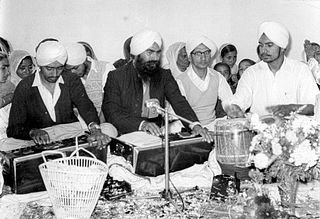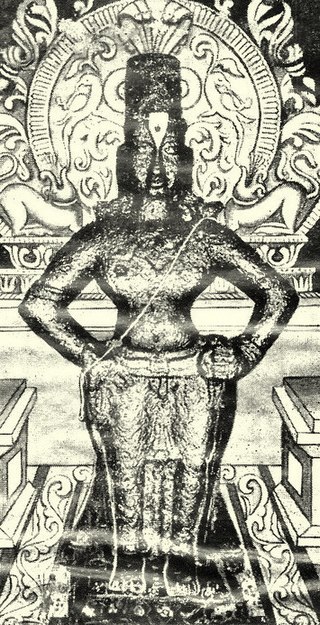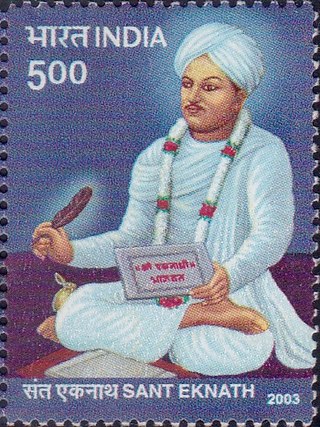Related Research Articles
Bhakti is a term common in Indian religions which means attachment, fondness for, devotion to, trust, homage, worship, piety, faith, or love. In Indian religions, it may refer to loving devotion for a personal God, a formless ultimate reality or for an enlightened being. Bhakti is often a deeply emotional devotion based on a relationship between a devotee and the object of devotion.

The Bhakti movement was a significant religious movement in medieval Hinduism that sought to bring religious reforms to all strata of society by adopting the method of devotion to achieve salvation. Originating in Tamilakam during 6th century CE, it gained prominence through the poems and teachings of the Vaishnava Alvars and Shaiva Nayanars before spreading northwards. It swept over east and north India from the 15th century onwards, reaching its zenith between the 15th and 17th century CE.

Sant Dnyaneshwar, also referred to as Dnyaneshwar, Dnyanadeva, Dnyandev or Mauli or Dnyaneshwar Vitthal Kulkarni (1275–1296), was a 13th-century Indian Marathi saint, poet, philosopher and yogi of the Nath and Varkari tradition. In his short life of 21 years, he authored Dnyaneshwari and Amrutanubhav. These are the oldest surviving literary works in the Marathi language, and considered to be milestones in Marathi literature. Sant Dnyaneshwar's ideas reflect the non-dualistic Advaita Vedanta philosophy and an emphasis on Yoga and bhakti towards Vithoba, an incarnation of Vishnu. His legacy inspired saint-poets such as Eknath and Tukaram, and he is one of the founders of the Varkari (Vithoba-Krishna) Bhakti movement tradition of Hinduism in Maharashtra. Dnyaneshwar undertook samadhi at Alandi in 1296 by entombing himself in an underground chamber.

Kirtana, also rendered as Kirtan or Keertan, is a Sanskrit word that means "narrating, reciting, telling, describing" of an idea or story, specifically in Indian religions. It also refers to a genre of religious performance arts, connoting a musical form of narration, shared recitation, or devotional singing, particularly of spiritual or religious ideas, native to the Indian subcontinent. A person performing kirtan is known as a kirtankara.

The Bhagavata Purana, also known as the Srimad Bhagavatam, Srimad Bhagavata Mahapurana or simply Bhagavata (Bhāgavata), is one of Hinduism's eighteen great Puranas (Mahapuranas). Composed in Sanskrit and traditionally attributed to Veda Vyasa, it promotes bhakti (devotion) towards Krishna, an avatar of Vishnu, integrating themes from the Advaita (monism) philosophy of Adi Shankara, the Vishishtadvaita of Ramanujacharya and the Dvaita (dualism) of Madhvacharya. It is widely available in almost all Indian languages.

Sant Tukaram Maharaj, also known as Tuka, Tukobaraya, Tukoba, was a Hindu, Marathi Saint of Varkari sampradaya" in Dehu village, Maharashtra in the 17th century. He was a bhakt of the god Vithoba of Pandharpur. He is best known for his devotional poetry called Abhanga, which are popular in Maharashtra, many of his poems deals with social reform.

Namdev, also transliterated as Nam Dayv, Namdeo, Namadeva, was a Marathi Vaishnava saint from Narsi, Hingoli, Maharashtra, Medieval India within the Varkari tradition of Hinduism. He was as a devotee of the deity Vithoba of Pandharpur.

Mahipati was an 18th century Marathi language hagiographer who wrote biographies of prominent Hindu Vaishnava sants who had lived between the 13th and the 17th centuries in Maharashtra and other regions of India.

Warkari is a sampradaya within the bhakti spiritual tradition of Hinduism, geographically associated with the Indian state of Maharashtra. Warkaris worship Vitthal, the presiding deity of Pandharpur, regarded as a form of Vishnu. Saints and gurus of the bhakti movement associated with the Warkaris include Dnyaneshwar, Namdev, Chokhamela, Eknath, and Tukaram all of whom are accorded the title of Sant. Recent research has suggested that the Varkaris were historically the followers of Krishna. Vittala is also another name for Krishna. Krishna is referenced as Vittala in most Bhakthi songs of Purandara Dasa and other Bhakti Saints.

Vithoba, also known as Vitthala, and Panduranga, is a Hindu deity predominantly worshipped in the Indian state of Maharashtra and Karnataka. He is a form of the Hindu deity Vishnu in his avatar: Krishna. Vithoba is often depicted as a dark young boy, standing arms akimbo on a brick, sometimes accompanied by his consort Rakhumai.

Pundalik or Pundarika is an Indian saint and a devotee of the Hindu deity Vithoba. Vithoba is a Vaishnava deity and a recincarnation of Vishnu and Krishna. Pundalik is thought to have brought Vithoba to Pandharpur, where Vithoba's main shrine stands today. Pundalik is also the historical founder of the Varkari sect, which is centered on the worship of Vithoba.

Chokhamela was a Hindu saint in Maharashtra, India in the 14th century. He belonged to the Mahar caste,, which was considered that time one of the low castes in India. He was born at Mehuna Raja, a village in Deulgaon Raja Taluka of Buldhana district. He lived at Mangalvedha in Maharashtra. He wrote many Abhangas. One of his known Abhangas is 'Abir Gulal Udhlit Rang". Social activist Arvind Prabhakar Kayande Started Celebrating "Chokhamela Festival" in Deulgaon Raja. He was one of the first low-cast poets in India.

Sena Nhavi, also known as Saint Sena, and Sena, is a Hindu saint-poet (sant-kavi) of the Varkari sect dedicated to the god Vithoba.
Visoba Khechara, spelled also as Visoba Khechar or Visoba Khecar, was the yogi-guru of the Varkari poet-saint Namdev (c.1270-1350) of Maharashtra, India. Visoba was a disciple of the Varkari poet-saint Jñāneśvar. He had linkages with the Varkari tradition as well as the Nath tradition of Maharashtra. Though a staunch Shaiva, Visoba has composed verses in praise of the god Vithoba, the patron deity of the Varkari faith. He has also composed a metaphysical treatise called the Shatsthala.

Kanhopatra was a 15th-century Marathi saint-poet, venerated by the Varkari sect of Hinduism.
Bir Kuar or Birkuar, also known as Birnath, is a Hindu god worshipped by Yadavs of western Bihar in India. He is considered to be a form of god Krishna and was born in Krishnaut clan of Ahir. He is worshipped in form of wooden posts that depict him standing arms-akimbo. Bir Kuar is honoured as the protector of cattle.

Eknath (1533–1599), was an Indian Hindu saint, philosopher and poet. He was a devotee of the Hindu deity Vitthal and is a major figure of the Warkari movement. Eknath is often viewed as a spiritual successor to the prominent Marathi saints Dnyaneshwar and Namdev.
Bhanudasa (1448–1513), was a Hindu sant who brought back the sacred image of the god Vithoba back from Vijayanagara to Pandharpur, its original location. He was Eknath’s great grandfather. As a boy he worshipped the Sun but later came to worship Vithoba. He is the subject of two chapters in the Bhaktavijaya. His Samadhi situated in solkhambi mandap of Vitthal temple at Pandharpur.
Narahari Sonar or Narharidas was a 13th-century Hindu poet-saint of the Varkari sect and goldsmith (sonar) from Maharashtra, India. His hagiography speaks about his transition from a staunch Shaiva to a Vithoba-worshipping Varkari after a miracle that makes him realize that Vithoba and Shiva are one and the same.

Mukund Lath was an Indian scholar and cultural historian, known for his writings on music, dance, aesthetics and culture of India. He was honored by the Government of India, in 2010, with the fourth highest Indian civilian award of Padma Shri.
References
Notes
Citations
- ↑ Abbott, Justin E. (1933). Stories of Indian Saints: An English Translation of Mahipati's BhaktiVijaya, Volume 1. Motilal Banarasidass Publishers. pp. Chapter 9, 34–45. ISBN 8120804694.
- ↑ Novetzke, Christian Lee (1969). Religion and Public Memory: A Cultural History of Saint Namdev in India. New York Chichester: Columbia University Press. p. 53. ISBN 978-0231-14184-0.
- ↑ Winand M. Callewaert; Rupert Snell (1994). According to Tradition: Hagiographical Writing in India. Otto Harrassowitz Verlag. pp. 162–166. ISBN 978-3-447-03524-8.
- ↑ Abbott, Justin E. (1995). Stories of Indian Saints: An English Translation of Mahipati's BhaktiVijaya(Vol I an II). Motilal Banarasidass Publishers.